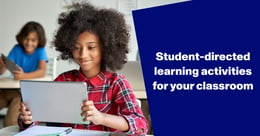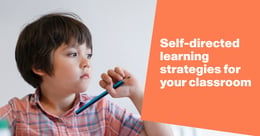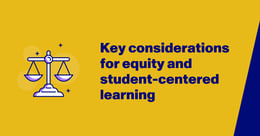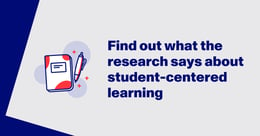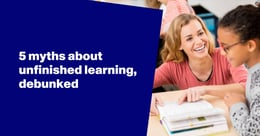
What does 21st-century learning look like for our schools?
More than 20 years into this new and exciting era, education leaders are still exploring and redefining what’s possible for 21st-century learning.
Bolstering academic achievement is certainly key to preparing students for higher education and real-world career pathways. In addition, life skills and a broader set of future readiness criteria are expanding our notions of what college and career readiness looks like for the coming decades.
What kind of education do students need in order to be successful in the 21st century, and how can administrators and educators take concrete steps to realize these aspirations?
A foundation for learning in the 21st century: Skills and strategies
The Partnership for 21st Century Learning (P21) has consulted with leaders in the education field to determine which skills and abilities today’s students need to thrive. Crucial elements in the organization’s 21st-century learning framework include:
- Incorporating 21st-century themes, such as global awareness, into the three R’s and other traditional key subjects.
- Promoting literacy skills in important 21st-century domains, such as media, technology, and information literacy.
- Readying students for success in life and their careers by fostering social skills, a sense of responsibility, adaptability, and more.
The framework also emphasizes a set of 21st-century competencies centered on learning and innovation known as the four C’s:
- Creativity
- Critical-thinking skills
- Communication skills
- Collaboration
It’s important to keep in mind that this model isn’t set in stone. P21 expects to update it occasionally.
Still, in the context of this framework, it’s clear that schools interested in 21st-century learning have their work cut out for them. Individual lessons and units have to promote themes that are vital for today’s students, and teachers are tasked with preparing learners for engaged problem-solving and to be fluent in today’s media and tech landscape while also being strong collaborators and teammates.
It’s a tall order, but the opportunity before us is just as exciting as it is challenging. So what might this look like in practice?
How to incorporate 21st-century skills into the classroom for K-12 students
When possible, some districts are certainly investing in facility upgrades to help construct physical spaces that are conducive to the development of 21st-century skills. For example, in Columbus, Indiana, representatives from the school district recently hosted a tour of renovations taking place at a local elementary school. Among other upgrades, officials highlighted a new STEM lab, an emotional wellness center, and improvements that are intended to promote collaborative learning.
But construction projects alone aren’t enough. To bring 21st-century learning skills into focus, administrators will need to balance several unique aspects of the school system. These factors include:
- Learning environment: A resource from the State Educational Technology Directors Association about 21st-century learning environments highlighted the importance of providing students with educational spaces where technology is richly integrated into their everyday activities. In addition to investments in hardware and software, this also requires robust professional development opportunities and other resources to support teachers as they integrate new high-tech elements into classroom routines and create exciting opportunities for students.
- Lesson planning: An Edutopia article about 21st-century lesson plans explores how teachers can weave the four C’s into their curricula. In particular, the write-up focuses on ELA instruction and elements of media literacy, but the featured activities could be fruitful for instructors in other subjects too. For example, the author described how they encouraged students in their classroom to create podcasts and videos and how they fostered the ability to work in groups using digital collaboration tools.
- Support for all students: In its exploration of key strategies for inclusive 21st-century learning, the National Center for Learning Disabilities emphasized the importance of several different educational tactics and attributes. Specifically, the report underscores the need for self-advocacy and self-direction, comprehensive support, holistic measurement, growth mindsets, and robust learning opportunities powered by collaboration—including partnerships between special education teachers and other classroom instructors. Likewise, to ensure everybody's needs are met, English-language teaching support should help students acquire these skills too.
High schools leaning into 21st-century learning
Some high schools are leveling up their offerings for today’s learners by rolling out new career-focused classes. With these enhanced learning opportunities, students get a leg up in gaining the hard skills required for several growing 21st-century career paths while also finding out just what it takes to be successful at an in-demand job.
Take one New Jersey school system as an example: In the South Brunswick School District’s newly launched Career Academy, cohorts of local high school students learn computer science, participate in relevant internships, complete capstone projects, undertake dual-enrollment coursework, and more. The New Jersey district’s Career Academy is expected to expand into other disciplines in the future.
Similarly, many high schools throughout the country are rethinking their approach to career and technical education to prepare students for 21st-century opportunities.
Embracing STEM in elementary and middle school environments
It’s never too early to get students excited about building the skills they’ll need for today’s top careers.
That’s why a Philadelphia Lego competition for middle school students was such a success. The initiative reflected the combined efforts of Andrew Hamilton School, the School District of Philadelphia, and the Philadelphia Robotics Coalition. More broadly speaking, the event is also a result of the school’s expanded efforts to promote technology literacy, robotics instruction, and STEM exploration for students in all grade levels.
21st-century learning beyond the K-12 classroom
Indisputably, K-12 leaders have a vital role to play in ensuring that today’s students are prepared for tomorrow’s world. Of course, when children have a strong foundation in 21st-century learning strategies before they even start kindergarten, they’re ready to hit the ground running.
Additionally, many education leaders believe in the importance of collaborating with future-focused community centers—or establishing their own after-school programs through grants and other mechanisms—to help support students outside the classroom.
Early childhood education with a 21st-century approach
Helping children develop 21st-century skills is a good way to set the stage for learning experiences that take place in K-12 instruction.
Specifically, guidance from P21 on early childhood 21st-century learning focuses on supporting kids by providing:
- Clear—but flexible—expectations
- Exposure to diverse perspectives
- Opportunities for children to share their work
Community centers focused on 21st-century learning
Through the Nita M. Lowey 21st Century Community Learning Centers program, certain initiatives—sometimes referred to as 21st CCLCs—have been established to offer academic enrichment opportunities outside the regular classroom. In one example, ELO Potter Brainery, an after-school program in Ohio, provides a camp-style atmosphere for students in third and fourth grade from the afternoon to the early evening. There, participants can learn about STEM concepts, build their social-emotional skills, and have fun together in a nurturing environment where their interests and curiosities shape the agenda.
Wide-ranging efforts to prepare students for lifelong learning
In total, supporting student achievement through 21st-century learning is a vast undertaking. STEM clubs and tech-enabled schools are certainly important, but it’s just as vital that we help learners build the soft skills they’ll need to succeed in the years to come.
Looking for more information about how to help students cultivate 21st-century skills? Check out our latest ebook, “5 ways student-centered interventions can increase engagement.”

